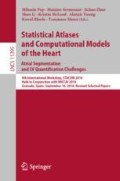Abstract
Cardiovascular disease caused by coronary artery disease (CAD) is one of the most common causes of death worldwide. Coronary artery segmentation has attracted increasing attention since it is useful for better visualization and diagnosis. Conventional lumen segmentation methods basically describe vessels by a rough tubular model, thus presenting inferiority on abnormal vascular structures and failing to distinguish exact coronary arteries from vessel-like structures. In this paper, we propose a context aware 3D fully convolutional network (FCN) for vessel enhancement and segmentation in coronary computed tomography angiography (CTA) volumes. Combining the superior capacity of CNN in extracting discriminative features and satisfactory suppression of vessel-like structures by spatial prior knowledge embedded, the proposed approach significantly outperforms conventional Hessian vesselness based approach on a dataset of 50 coronary CTA volumes.
Access this chapter
Tax calculation will be finalised at checkout
Purchases are for personal use only
Notes
- 1.
Public implementation by Kroon, D.J. https://ww2.mathworks.cn/matlabcentral/fileexchange/24409-hessian-based-frangi-vesselness-filter.
References
Roger, V.L., et al.: Heart disease and stroke statistics-2012 update: a report from the american heart association. Circulation 125(1), e2–e220 (2012)
Frangi, A.F., Niessen, W.J., Vincken, K.L., Viergever, M.A.: Multiscale vessel enhancement filtering. In: Wells, W.M., Colchester, A., Delp, S. (eds.) MICCAI 1998. LNCS, vol. 1496, pp. 130–137. Springer, Heidelberg (1998). https://doi.org/10.1007/BFb0056195
Lesage, D., Angelini, E.D., Bloch, I., Funka-Lea, G.: A review of 3D vessel lumen segmentation techniques: models, features and extraction schemes. Med. Image Anal. 13(6), 819–845 (2009)
Zheng, Y., Loziczonek, M., Georgescu, B., Zhou, S.K., Vega-Higuera, F., Comaniciu, D.: Machine learning based vesselness measurement for coronary artery segmentation in cardiac CT volumes. In: Proceedings of the SPIE 7962, Medical Imaging 2011: Image Processing. p. 79621K (2011)
Chen, F., Li, Y., Tian, T., Cao, F., Liang, J.: Automatic coronary artery lumen segmentation in computed tomography angiography using paired multi-scale 3D CNN. In: Proceedings of the SPIE 10578, Medical Imaging 2018: Biomedical Applications in Molecular, Structural, and Functional Imaging, p. 105782R (2018)
Çiçek, Ö., Abdulkadir, A., Lienkamp, S.S., Brox, T., Ronneberger, O.: 3D U-Net: learning dense volumetric segmentation from sparse annotation. MICCA I, 424–432 (2016)
Milletari, F., Navab, N., Ahmadi, S.A.: V-Net: Fully convolutional neural networks for volumetric medical image segmentation. In: Fourth International Conference on 3D Vision (3DV), pp. 565–571. IEEE (2016)
Zhou, S.K.: Discriminative anatomy detection: classification vs regression. Pattern Recognit. Lett. 43, 25–38 (2014)
He, K., Zhang, X., Ren, S., Sun, J.: Deep residual learning for image recognition. In: CVPR, pp. 770–778 (2016)
Lin, T.Y., Goyal, P., Girshick, R., He, K., Dollar, P.: Focal loss for dense object detection. In: ICCV, pp. 2980–2988 (2017)
Yang, X., Bian, C., Yu, L., Ni, D., Heng, P.A.: Hybrid loss guided convolutional networks for whole heart parsing. In: International Workshop on Statistical Atlases and Computational Models of the Heart, pp. 215–223 (2017)
Acknowledgement
This work is supported by the National Natural Science Foundation of China under Grant 61622207.
Author information
Authors and Affiliations
Corresponding author
Editor information
Editors and Affiliations
Rights and permissions
Copyright information
© 2019 Springer Nature Switzerland AG
About this paper
Cite this paper
Duan, Y., Feng, J., Lu, J., Zhou, J. (2019). Context Aware 3D Fully Convolutional Networks for Coronary Artery Segmentation. In: Pop, M., et al. Statistical Atlases and Computational Models of the Heart. Atrial Segmentation and LV Quantification Challenges. STACOM 2018. Lecture Notes in Computer Science(), vol 11395. Springer, Cham. https://doi.org/10.1007/978-3-030-12029-0_10
Download citation
DOI: https://doi.org/10.1007/978-3-030-12029-0_10
Published:
Publisher Name: Springer, Cham
Print ISBN: 978-3-030-12028-3
Online ISBN: 978-3-030-12029-0
eBook Packages: Computer ScienceComputer Science (R0)

